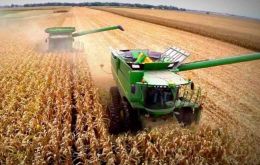MercoPress. South Atlantic News Agency
Tag: world cereal stock
-
Thursday, February 11th 2021 - 08:18 UTC
FAO anticipates a sharp decline in global cereal stocks

FAO's Cereals Supply and Demand Brief point to record wheat and rice production in 2020 and looking ahead to 2021 cereal output, early prospects indicate a likely modest increase for winter wheat crops in the northern hemisphere, buoyed by acreage increases in France, India, the Russian Federation and the US.
-
Friday, February 5th 2016 - 08:31 UTC
World cereal stocks are set to end 2016 seasons at 642 million tons, higher than they began.

Weather patterns associated with El Niño are sending mixed signals about the early prospects for cereal crops in 2016, especially in the Southern Hemisphere, according to FAO's Cereal Supply and Demand Brief, released on Thursday.
-
Saturday, May 10th 2014 - 00:05 UTC
Despite some setbacks, FAO expects second largest cereal production this year

Weather conditions in various countries and political tensions in the Black Sea region have made food markets more volatile, FAO reports in the new Food Outlook. In its first major forecast for 2014, FAO puts cereal production at 2 458 million tons (including milled rice), down some 2.4% from the 2013 record, though global output is still expected to be the second largest ever.
-
Saturday, January 18th 2014 - 05:50 UTC
Global cereal production in 2013 and outlook revised upward, says FAO

FAO’s latest forecast for world cereal production in 2013 has been revised upward marginally (2 million tons) since November to a new high of almost 2 500 million tons (including rice in milled terms), 8.4% more than last year and some 6% above the previous record in 2011.
